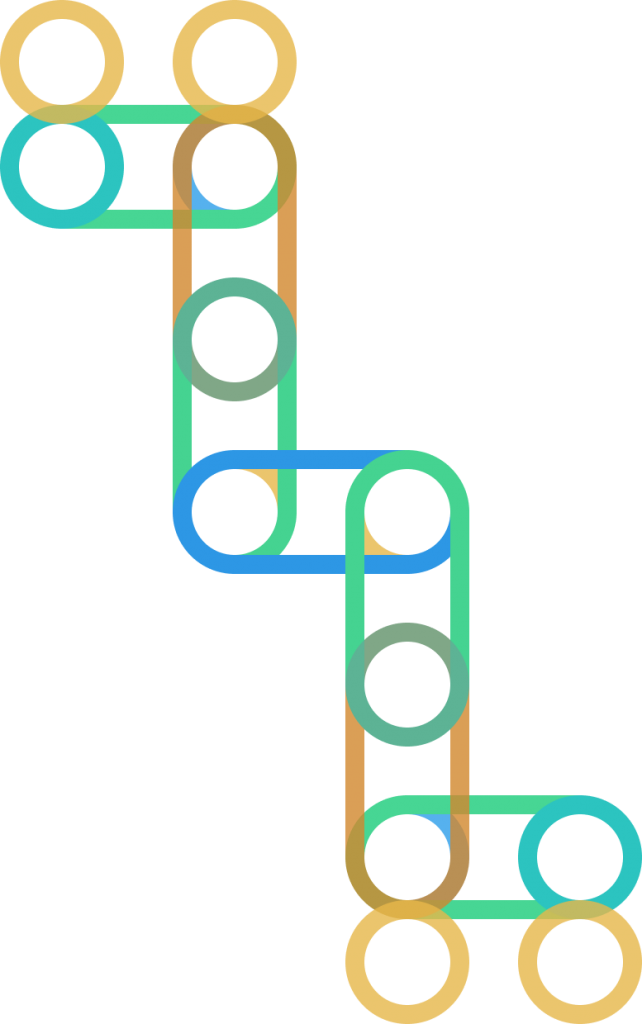
Understanding the complexity of the interdependence of all things, the harmonious dance that we see every day in nature, is crucial to unlocking the plastic paradox.

The issue of our dependence on plastic and the clamor from environmentalists in recent years to “break free from plastic” is one of the most challenging conundrums facing humans as we seek to unwind the damage we have inflicted on our natural habitats.
A misplaced idea that we can somehow simply replace the material and “free” ourselves from a vice-like grip over us is to totally miss the point of systems thinking, which is such an important pillar of the regenerative movement.
Systems thinking seeks to broaden our understanding of how the world works before making knee jerk decisions that take us from one series of bad decisions to another. Decisions that simply compound on each other over time.
Clearly the world has a problem with plastic waste but until we can fully understand the systemic issue surrounding the material we will struggle to find a solution – not to our dependence on plastic – but to our interdependence with the material.
The Ellen MacArthur Foundation has been trying to bring systems thinking into the mainstream with its push towards a more circular economy, helping us to rethink some of the challenges surrounding plastic waste and the plastic industry’s contribution to (and reduction of) greenhouse gas emissions.
For years, reductionism has been the dominant scientific approach, providing us with a dominant filter through which we see the world and try to understand things by simply analyzing individual parts in isolation.
This has brought us to our current predominant vision of the world as a machine, serving principally the economic needs of our species.
LINEAR REDUCTIONISM
As the Ellen MacArthur Foundation argues, “Our current linear economy is one example of a man-made system that reflects this. It is like a machine – resources go in and waste comes out, a conveyor belt process in which the primary goal is to increase efficiency and drive endless economic growth. It is an abstracted economy, divorced from any connection to the broader natural and social systems that maintain it.”
Plastic is perhaps the best – if not the only – manifestation of the linear economy with recycling rates of as little as 9% of all plastic ever produced. Which is to say, 91% of all plastic was produced but not used to create more plastic.
It’s a statistic that screams inefficiency but also reflects the material’s success in replacing other alternative materials that may have had worse impacts on our planet – plastic was invented first to replace the use of ivory for instance.
There are many reasons why the amount of plastic recycled is so low – one being that not all plastics are the same making their re-use extremely complicated and another example of how reductionism becomes an obstacle in identifying the real issue – which is our behavior not the material itself. Not all plastics suffer from the same levels of reuse and recycling.
Lacking in this reductionist analysis is a basic understanding of the interdependence of all things and the delicate interplay between systems.
Systems expert, Donella Meadows, describes a system as “an interconnected set of elements that is coherently organised in a way that achieves something”. One of the leading figures of the regenerative movement, Meadows writes:
“In a forest there are many elements that determine the overall health of the system, including the soil, plant life, animals, insects, and bacteria. Take insects, for example, they aerate the soil, pollinate blossoms, help control pests, and decompose detritus and foliage that helps build a nutrient-rich layer of soil that supports plant growth. Remove insects from the system and it will have far-reaching consequences.”
The same is every bit as true when we talk about plastic which is now an intrinsic part of our world with as many positive implications as well as the obvious negative ones.
If we look at just the environmental challenges, solutions would be much easier to implement; but we also need to look at social and economic challenges too.
As the EMF points out; “Ocean plastic is a result of our reliance on single-use plastics, lack of consumer education and awareness, poor product design, business practices and incentives, and a lack of finance and infrastructure among other things”.
All of these things need to be addressed and none of them can be looked at in isolation. EMF’s efforts to bring all the stakeholders involved in the Plastics Economy together to work on practical solutions together is the most notable effort to bring systems thinking into the mainstream.
PET POLYMERS’ REGENERATIVE PATH
The AdaPETation Network is an example of how the PET Polymers industry is trying to find its own regenerative path.
The regenerative movement would argue that the first step on any transition is to fully understand the level of interdependence an organism has with the systems with which it engages.
In this respect, the PET industry, composed of multiple companies – feeding largely from the output of the world’s largest polymer producers – the likes of chemical giants, DOW, Indorama, Ineos, etc, who source their products from publicly and privately owned oil and gas companies.
These chemical companies in turn integrate with their own networks, packaging companies that serve consumer goods companies that are in turn motivated by their customers – all of us.
And this system is funded by and in turn feeds the financial markets which is another system that links back to all of us in other ways through our pensions and other financial products.
All of these systems are highly interdependent even though at first glance they have been set up in the linear fashion that manifests itself in the plastic industry’s continued reliance on the use of virgin oil stocks for more than 97% of total production.
SYSTEMS THINKING & GREATER UNDERSTANDING
We cannot form a true understanding of these ‘systemic’ challenges unless we can appreciate how all of these elements interact to produce certain dynamics and behaviors. If we don’t understand the problem we cannot arrive at an adequate solution. So how might we apply systems thinking to the PET industry?
For the PET industry, introducing more circular loops in the form of recycling is one way to mimic nature and become less reliant on industries that are degenerative by nature like the oil industry. The introduction of biodegradable plastics and the creation of bioplastics that use “renewable” materials is another. Intelligent use of other resources and inputs – energy and water is another.
The more we study natural systems, the easier it is for us to change our vision and find alternative solutions. Biomimicry and the study of living systems is key to understanding interdependence at the most basic level.
Through biomimicry, we can see how efficient nature is. In the forests, or our oceans, ecosystems with 3.8 billion years of research and development, waste goes to productive use, cooperation and interconnection across multiple scales are crucial, regeneration occurs naturally over time.
When Michael Braungart, co-founder of the Cradle to Cradle design concept, which is a central pillar of circular economy thinking first wrote about biomimicry “In The Wisdom of the Cherry Tree”, he argued that effectiveness rather than mere efficiency should be the end goal for an economy or any system, for that matter.
“The cherry tree is just one part of a much bigger, interdependent natural ecosystem and it is this interdependence that matters. For example, the blossoms of the cherry tree not only bring forth a new generation of cherry trees… they also provide food for micro-organisms which in turn nourish the soil and support the growth of future plant life. The ‘outputs’ – indeed ‘waste’ – of one process (the cherry tree and its blossoms) have become inputs for other processes. When viewed in isolation, each element within this natural system may be highly inefficient. But as a whole, the system is stunningly effective – and doesn’t produce any waste at all. We need to apply the cherry tree’s wisdom to the world of production and consumption.’
STUNNINGLY EFFECTIVE
How can the PET polymers industry become “stunningly effective”? As an industry it’s already proved to be just that by creating a level of interdependence with so many other systems. PET has become ubiquitous in almost everything. There is no question that PET polymers are already stunningly effective in one sense. Where it fails in Braungart analysis of nature is “not producing any waste at all”.
In this sense, cooperation and interconnection across multiple scales will be crucial to ensure that regeneration occurs naturally over time.
For the PET polymers industry, systems thinking can be an enabling tool that can help identify root causes and implement better solutions, and it can also provide an important lens or frame for our conceptual understanding of it.
The systems perspective allows for a more accurate and nuanced understanding of the PET polymers industry as one part of a much larger whole.
As Carol Sanford, one of the leading figure of the regenerative movement for 40 years argues, “A paradigm and accompanying set of capabilities that consider any life form as singular, able to express and grow itself to contribute that essential singularity, over time, to nested wholes in which it is embedded, with reciprocity. It can only be regenerated if pursued as a value-adding process.”
Being able to see the whole allows us to see economic activity differently. Using the living systems analogy and biomimicry a new vision of the economy is revealed, not as a machine but as a forest.
“Rather than mere throughput of materials, it is the circulation of materials that allows life to flourish – things grow, they die, and then nutrients are returned to the system to feed new life. The success of the forest is not measured by the endless growth of its trees but by its ability to reach maturity and thrive in a state of equilibrium with all that surrounds it,” writes Sanford.
And system she adds: “lives and thrives or dies based on the nested wholes in which it lives. Biota lives in soil, embedded into vegetation, in a specific watershed and ecosystem. Nothing is isolated and much is determined by other aspects of the system. But each entity contributes to it working effectively or else it is extractive from the health of the whole. That is the reciprocity. Understanding the working of the nested whole allows humans to intervene beneficially and not extractively.”
In the same way PET packaging companies are dependent on their customers, large scale consumer goods companies are reliant on farmers, who are in turn wholly dependent on the health of their land and other systems that replenish their soil.
Agriculture and industries are interdependent without one, the other cannot develop.
The health of our farms depends on the health of our soils and so investing in regenerative farming has been highlighted by consumer goods giants like Nestle, as the single biggest impact it can have on its greenhouse gas emissions.
How does PET fit into this bigger picture? What can it do to help agriculture thrive so that it too can thrive well into the future?
A future fit company from whatever industry, is one that gives something back to the nested whole in which it belongs.
As part of the AdaPETation Network’s deep dive into how PET is powering ecosystem restoration around the world there was remarkably little evidence that the industry has thought much about its interdependence on agriculture, as part of the nested whole in which it is embedded.
As in nature, only with reciprocity can something be regenerated.
If you like this content and would like to help close the loop on plastic waste then join the AdaPETation Network by clicking on the button below.
Share it
Share it
Useful Links
THE HISTORY OF PLASTIC
Throughout the history of plastic, PET has been crucial in keeping food fresh with lightweight and durable packaging solutions that have helped reduce food waste for almost a century. Learn all about the invention of plastic and the important role it has played feeding people and saving the lives of humans and elephants in the adaPETation® timeline of the history of plastic.




